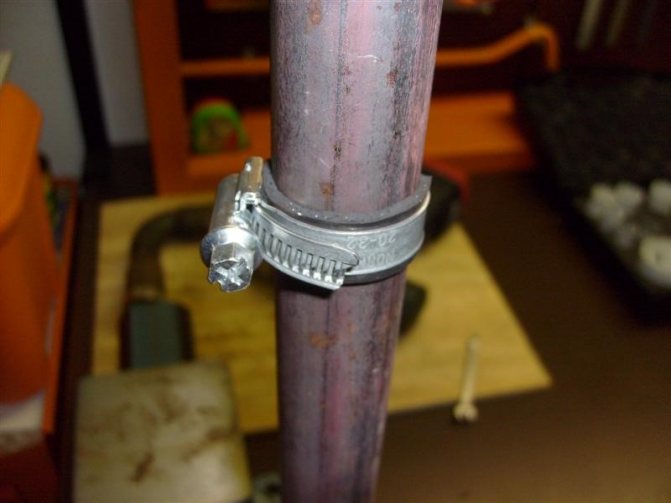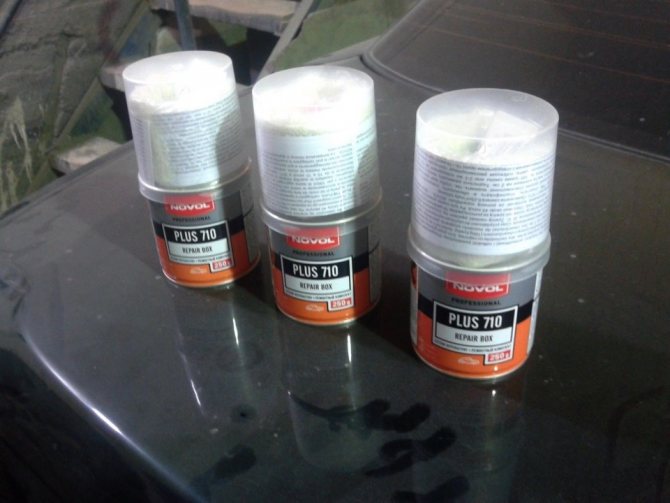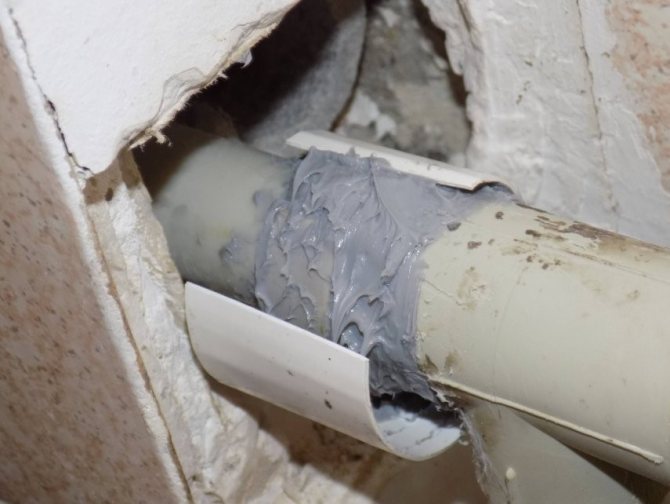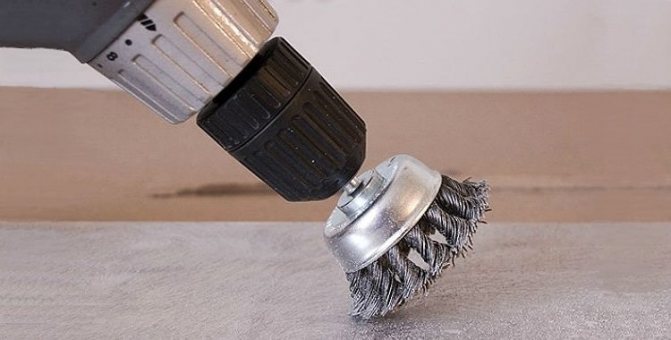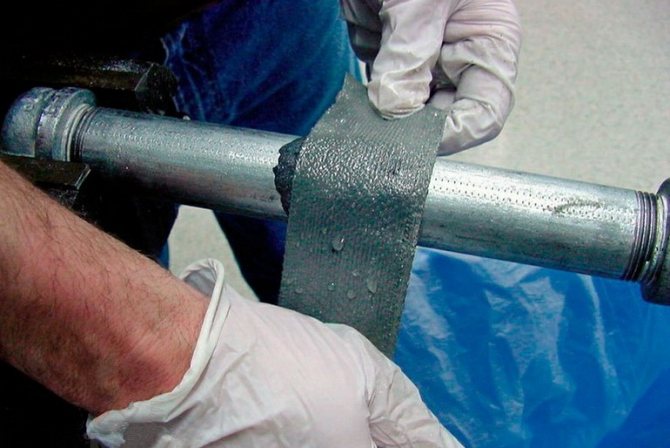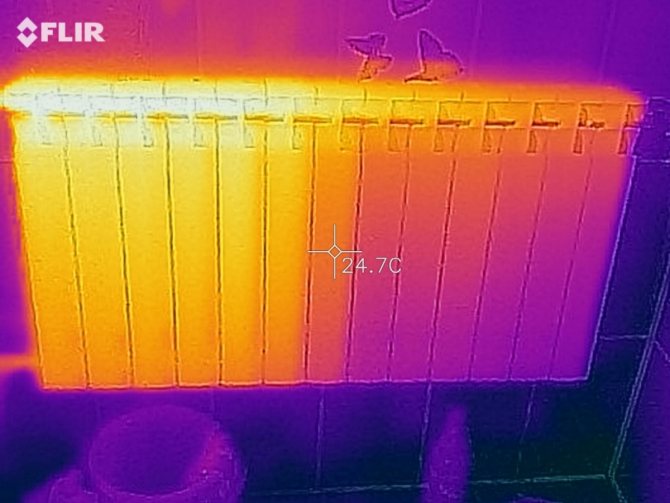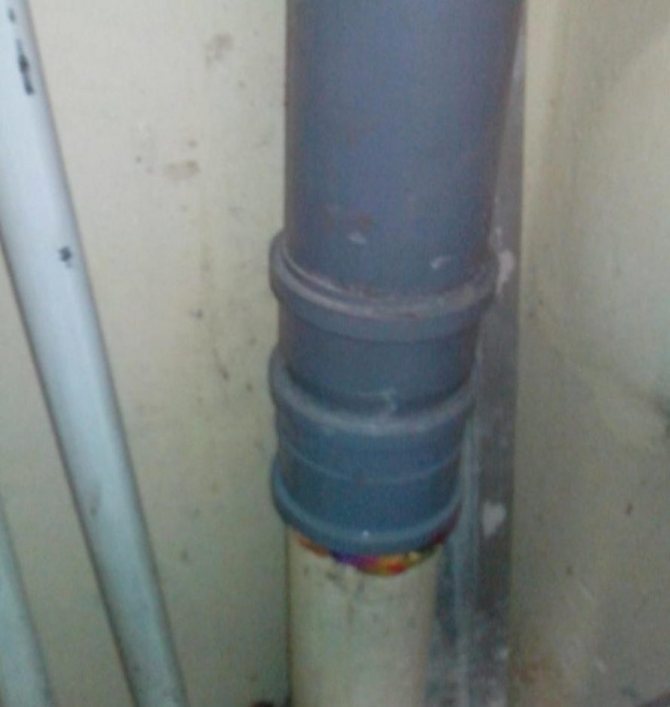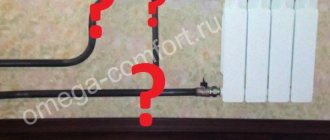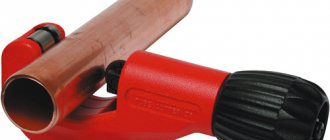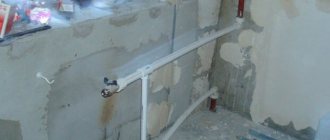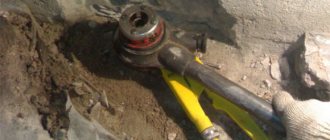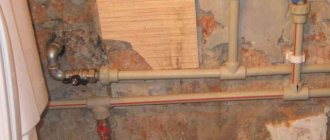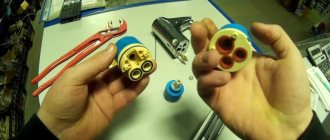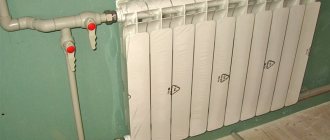Reasons for repairing the riser

Sewer riser
Repair work is most often carried out for the following reasons:
- The build-up of dirt inside cast iron pipes, where cleaning them with a plumbing cable does not bring positive results.
- Formation of small or large cracks in pipes, couplings or tees, which causes leaks and flooding of apartments located on the lower floors.
Replacing the sewerage system is always associated with certain difficulties and risks. An ideal option when the old sewer riser from the basement to the last floor is completely changed in a residential multi-storey building. However, there are often cases when it is necessary to replace the plumbing drainage system only in one apartment. Moreover, if the owner has professional skills for such work, he may well do it with his own hands.
Features of the process of installing a new riser
The installation of a new riser should be carried out as quickly as possible, because all the time of installation work you will not be able to use the toilet, bathroom and other communications that require a sewage system. Neighbors will also not be able to use these amenities.
Replacing a sewer riser in an apartment should be carried out with a person who has an idea of such work, since this process is quite complicated to perform.
The process of dismantling an old riser is much more complicated than installing a new one. Such work requires great care, accuracy and skill. The installation of a new pipeline is easier in this regard.
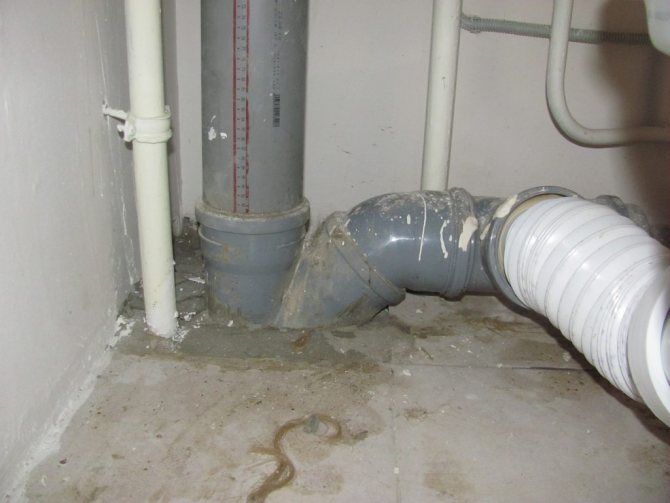

If you are not confident in your abilities, then it is better to turn to professionals to replace the riser
New riser installation process:
- The remaining scraps of the riser are sanded and aligned along the edges. A rubber cuff is attached to them. The connection is sealed with a special compound.
- A plastic adapter is placed on this cuff. It is very important to choose the correct product diameter.
- The same must be done with the bottom of the riser. You also need to put a plastic adapter there.
- The plastic pipe is installed in the adapters. All connections are carefully sealed. An expansion joint is installed in the tee.
This completes the installation. As you can see, the process cannot be called very complicated.
How to replace the old sewer riser?
Recently, plastic sewage systems have been most in demand.
The advantages of plastic pipes are:
- in their lightness;
- resistance to flow;
- no risk of clogging;
- convenience during transportation;
- simple installation rules;
- practicality in operation.
However, along with the positive qualities, plastic pipes also have a number of disadvantages. In particular, they do not work well at elevated temperatures.
With prolonged draining of liquid media at 60-degree temperatures, they begin to deform, and they withstand a load of 90 degrees for a short time.
New technologies today make it possible to use traditional materials as well. One of the options is a socketless cast-iron sewage system. These are modern cast iron pipes with an innovative coating that increases their stability and increases resistance during the movement of waste streams. Such pipes are easy to install, and for their connection they use special clamps equipped with elastic gaskets made of special EPDM rubber.
Technical equipment for work
To repair the drainage system with your own hands, you must have a set of plumbing tools.


Pipe connection
It includes:
- Bulgarian;
- a set of hammers;
- level;
- chisel;
- gas torch or blowtorch;
- measuring instruments;
- marker or pencils;
- personal protective equipment in the form of a gas mask, respirator and special glasses.
Difficulties in dismantling old pipes
Starting the repair of the riser, it is necessary to carefully examine it for clogging or cracks, and then determine the place of damage.
Then you need to:
- remove plumbing fixtures;
- disassemble the wiring, starting with short knees;
- disconnect the pipes leading to the bathtub, toilet and washbasin.


Joining of plastic and cast iron pipes
Removing the sulfur fill will be difficult in this work. Moreover, special care is needed when dismantling the old sewage system in order to avoid the destruction of the part of the system located in the ceiling. It is very difficult to do such work alone, so you need to enlist the support of an assistant.
Sulfur filling of old docking joints is removed by burning out with a blowtorch. In this case, it is necessary to observe safety measures and work in a gas mask so that toxic sulfur vapors do not enter the lungs.
It is advisable to dispose of the old pipe before the socket, so that later it would be easier to join the pipes. When working with cast iron pipes, care must be taken given their fragility. For dismantling, use hammers with a rubber or wooden attachment.
Removing the bottom of the cast iron pipe
Replacing the sewer riser
Further, the replacement of the sewer, or rather the riser, involves the removal of the lower piece of the old riser.
It usually consists of a number of parts or shaped elements. The design may include a cast iron revision, a coupling, an expansion pipe and others.
Let's describe the process:
- First, they check the strength of the pipe connection. For this purpose, they try to swing the upper section of the pipe. This should be done carefully so as not to damage the lower bell. In case of even the slightest swaying, carefully pull out all the dangling elements.
- If the cross (tee) "moves" at least a little in the joint area, it can be loosened with a nail puller or a crowbar and then removed. Further, with the installation of the riser, the sewer tee will also be replaced.
- If the crosses or the tee are fixed rigidly, it is necessary to clear the joint to the maximum possible depth, from time to time checking for swaying. If the width of the joint allows, for clearing, you can use a perforator with a thin drill installed on it without a winning tip.
- Carefully hollow out the solution at the joint along the perimeter, removing the remains of the solution with a chisel or a screwdriver.
- If the previous manipulations did not work, and the cross (tee) still holds very tightly, it is cut off with a grinder 2-3 centimeters above the bell.
Installation of drainage system
After dismantling, the repair of sewer equipment goes into the installation stage. For the riser, plastic pipes with a diameter of 110 mm are chosen, and for wiring to plumbing fixtures - 50 mm.
Installation is carried out in the following sequence:
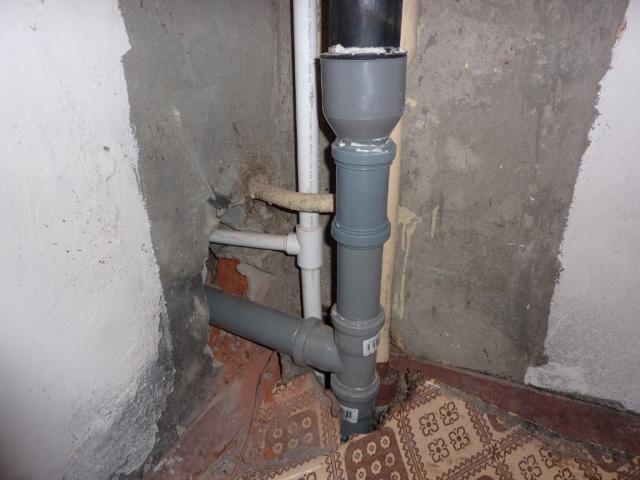

Sewerage structurally consists of pipelines
- The socket of the cast iron pipe is cleaned.
- A sliding joint or rolling collar can be used to connect the sewer system. Cuffs with a sliding joint are hammered all the way into a cast-iron socket, where a plastic pipe is inserted inside. The optimal joint density will be provided by the silicone sealant. After coating the sliding seal with a sealant, the pipes are pressed in further.
- When the cast-iron sewer pipes are replaced with plastic using a rolling collar, no lubricant is used, and the cuff itself is attached to the edge of the plastic.The cast-iron part of the joining parts is machined to be chamfered in the form of a cone.
- When joining parts relative to each other by rolling, the collar enters the bell, and the resulting joint is filled with a layer of sealant or cement for the reliability and strength of the connection.
- Do-it-yourself replacement of a sewer riser involves connecting a tee to an adapter for a plastic sewer. Only then can the toilet and other plumbing fixtures be connected. After that, the system is checked for leakage and the quality of the sealing of the joints.
Ways to eliminate leaks in the sewer system
The problem of how to eliminate a leak in a cast iron sewer pipe is solved in several ways, the choice of which depends on the strength of the pipeline, the presence of cracks and chips, and also their size.
Repair of sewer pipes without replacing the damaged area can be done in the following cases:
- The body has minor cracks and holes.
- A leak was detected at the junction of pipes.
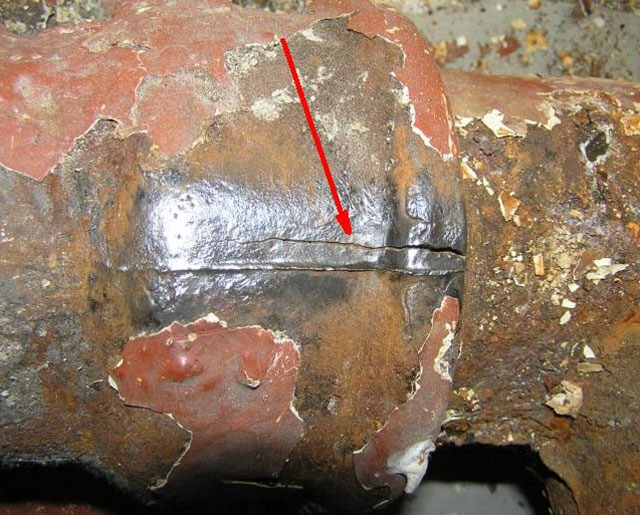

Leakage at the junction of sewer pipes implies sealing a cracked connection, for which the following steps are performed:
- The system is temporarily turned off.
- Dry the joint with a rag or hair dryer.
- Clean the joint from the cement and remove the packing from the cracks.
- Using a linen plumbing winding, a gap between the pipes is minted.
- Prepare a solution of polycement and PVA glue and coat the crack with it.
- It is recommended to start the operation of the sewer system only after a day.
A crack at the junction of sewer pipes can be closed with waterproof glue, epoxy resin, raw rubber, ordinary plasticine or a special silicone sealant. In the latter case, the sewage system can be used after 3 hours.
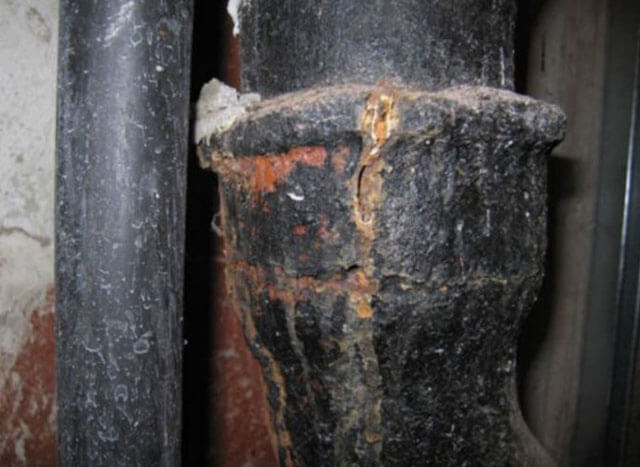

In order not to have to constantly deal with the repair of cast-iron sewer pipes, it is better to replace the part of the system that has become unusable before its final destruction. Otherwise, as a result of the failure of engineering communications, sewage can flood the apartments of the floors located below.
If the leak is caused by a small hole, you can use the following materials:
- Bandage-rubber... It is better to use such material for short-term repair of cast-iron pipes, while the bandage must be fixed with aluminum or copper wire.
- Plug... This repair element is a wooden wedge. When manufacturing, it is important that the product is not very long, as it can cause a blockage in the sewage system. The finished part is hammered at the leak and the pipe is wrapped with a strip of gauze. Finally, you can soak the material with epoxy.
- Gauze... This material, previously soaked in epoxy resin or cement mortar, is wrapped around the pipeline. Such a winding should be in the form of a cocoon.
- Special clamp... In this way, any leaks in the cast-iron sewer pipe are eliminated even if the water pipe burst. The repair process is as follows: a crack or hole is wrapped with a rubber gasket, covered with a clamp, which is then tightened. See also: "How and what to repair a leak in a sewer pipe - the rules for performing repairs."
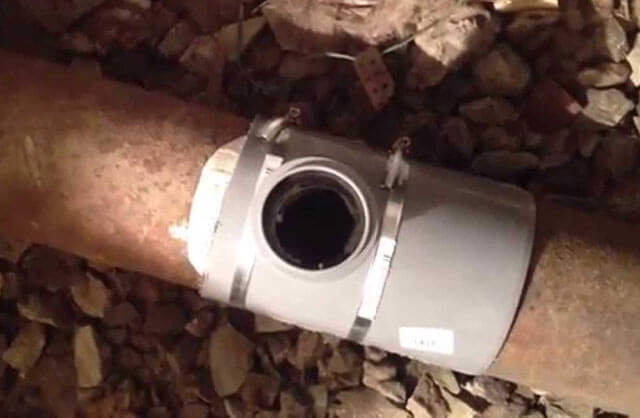

A small crack in a cast iron sewer pipe is eliminated in this way:
- The crack is widened to form a V.
- The site is degreased and dried well.
- Cover this place with sealant or silicone.
Replacing the riser
Before starting the installation of the piping system, you must completely inspect the sewer riser. If it cannot be repaired, it is replaced. Given the size of the damaged area, two cuts are made on the cast-iron pipe with a grinder at a distance of 15 cm from each other. The formed piece of pipe is removed, while freeing part of the riser.The replacement of this part of the sewage system is carried out with a grinder, observing safety rules.
Then an incision is made horizontally, followed by a bend of the lower part of the pipeline in the opposite direction.


Chimney at the ceiling
- The resulting cut is grinded with a disc in the form of a tapered chamfer.
- To remove the lower part of the riser, you can cut it at a distance of 30 cm from the socket.
- Further, in order to replace the sewer with your own hands, you will need a plastic pipe, 2 adapters and a compensator, which is put on the part until it stops.
- It is necessary to try on the length of self-assembled parts, taking into account the distance between the bell and the lower adapter. Cut off pipes 1 cm more. In case of a positive result, the entire riser is collected. At the same time, the use of rubber seals ensures reliable sealing.
- After sealing all the sewer connections, the plastic expansion pipe is driven into the outlet pipe located at the bottom of the riser.
Completing the repair of the riser, the pipes are fastened. The riser is fixed with clamps in three positions. Initially, two fasteners are installed on the ends, while ensuring free lowering of the expansion joint into the lower bell. After these works, the final installation of all plumbing fixtures is carried out.
Why do you need a replacement
In most cases, the sewage system in the apartment is made of cast iron. The fact is that earlier this material was used to organize such systems. Therefore, at the moment, the most urgent issue is the replacement of the cast-iron riser.
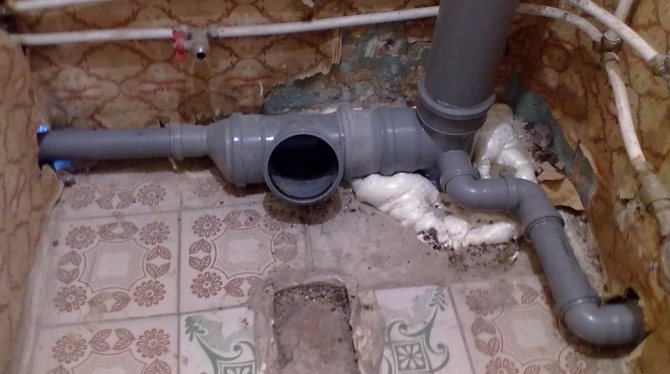

Sewer riser pipes are inexpensive
Previously, cast iron pipes were the best option for organizing any pipeline. However, more modern plastic, polypropylene and metal-plastic products have now been invented. They have a lot of advantages over the cast-iron version, so they often replace old cast-iron pipes.
Cast iron as a material for sewer pipes is not the best option. Such products are characterized by instability to corrosion and a very hard form. Because of this, they are overgrown from the inside with plaque, which interferes with the passage of wastewater. Therefore, more and more often, cast iron risers are replaced with plastic pipes.
When and why you need to replace the cast-iron sewage system:
- Cast iron has a porous structure. Therefore, a deposit of solid particles rapidly builds up inside pipes made of such material. It impairs the flow of drains and can cause unpleasant odors or damage to the entire system. Over time, they can be completely overgrown with bloom. Plastic is a more flexible and smoother material, so such problems do not threaten it.
- It is believed that the lifespan of a plastic sewer system is only 25 years. After this time, the pipes will need to be replaced.
- Sometimes cracks and fistulas appear on cast iron pipes. The repair of such pipes is irrelevant, so it is better to disassemble such a pipeline and change it to a plastic one.
By and large, it is quite possible to replace the sewer pipes on your own. And this is not as difficult to do as it might seem at first glance.
